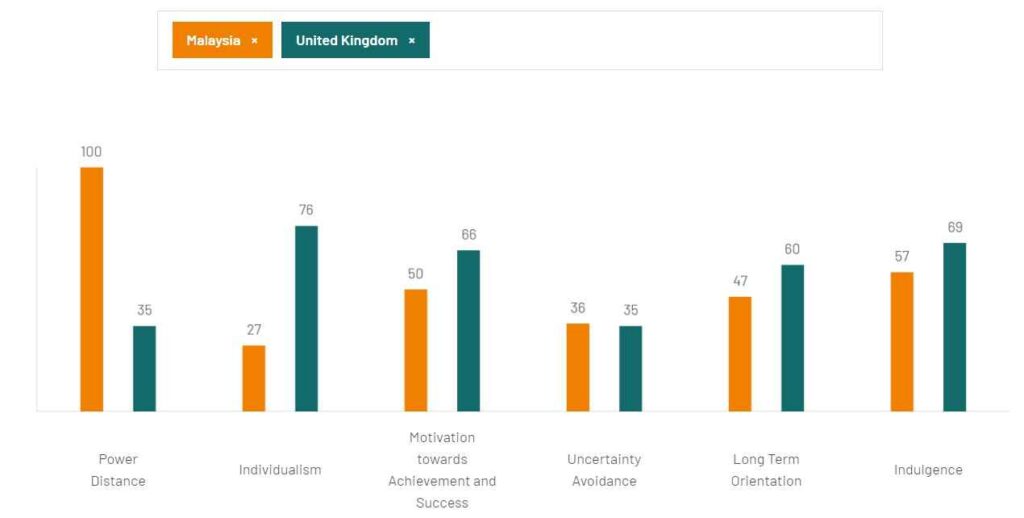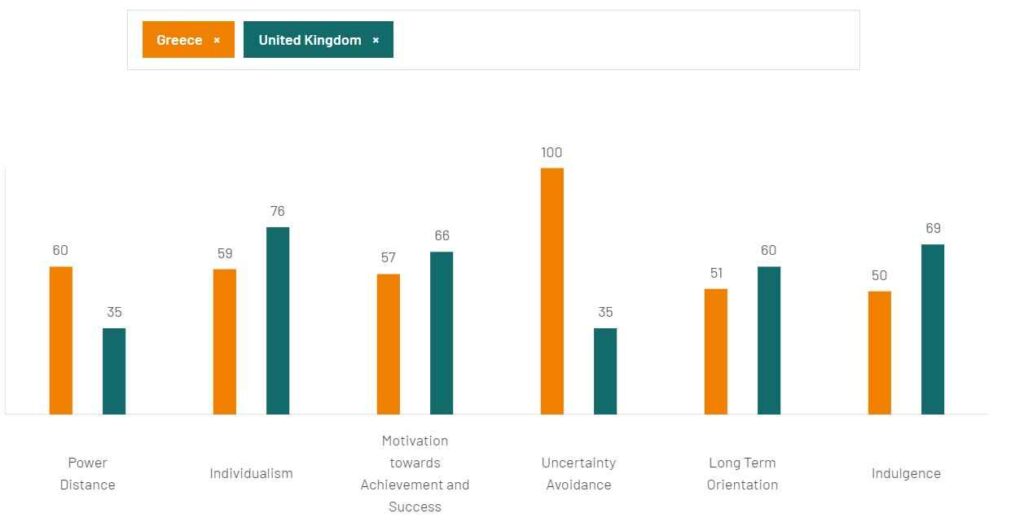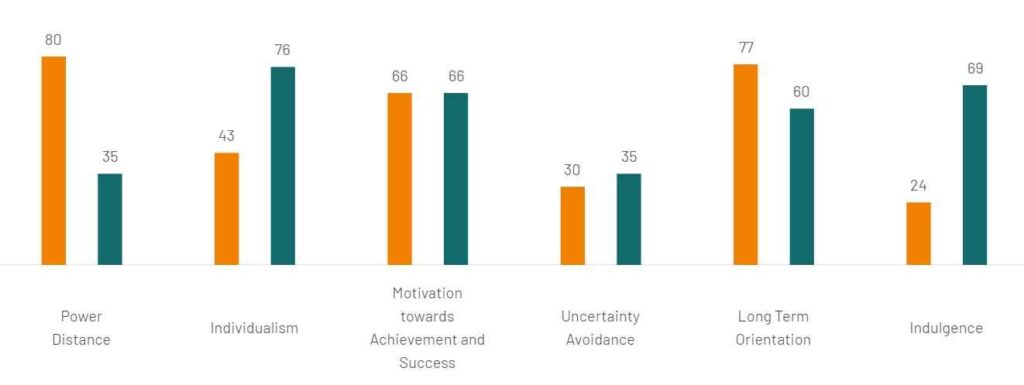ENHANCING CULTURAL AWARENESS IN THE WORKPLACE: A COMPARATIVE ANALYSIS OF HOFSTEDE’S CULTURAL MODEL AND THE GLOBE PROJECT DIMENSIONS
1. Introduction
Culture is a collection of beliefs, assumptions, and values of a social group that affects interaction with people and their external environment. Cultural awareness has become essential for businesses as it helps in creating a positive work environment. This study has evaluated Hofstede’s cultural model and the Globe Project dimensions to assess their usefulness in increasing cultural awareness among employees. It has also provided recommendations by considering one dimension from each model to provide strategies to a UK manager regarding their business expansion in China.
2. Critical evaluation of Hofstede’s Cultural model and The Globe Project
2.1. Assessment of Hofstede’s Cultural Model
Hofstede’s cultural model highlights six dimensions of differences regarding national culture. National culture has a significant impact on the organisational culture due to the effect of cultural values, traditions, and religions (Szydło & Grześ-Bukłaho, 2020). The six dimensions of the model are “power distance”, “individualism vs collectivism”, “masculinity vs femininity”, “uncertainty avoidance”, “long vs short-term orientation”, and “indulgence vs restraint” (Hofstede, 1984).
Power Distance Index
The “power distance index or PDI” measures the extent to which people within an organisation accept unequal distribution of power. A high PDI index indicates a hierarchical culture within the organisation, whereas a low PDI score indicates equal distribution of power with a flat organisational structure (Escandon-Barbosa et al. 2022). An organisation with a high PDI generally have an authoritative management style and managers rely on formal rules (Hofstede, 2009). For example, Malaysia has scored 100 in PDI indicating substantial power inequalities. On the other hand, the UK with 35 scores highlights its focus on equality in terms of power distribution (Hofstede-insights, 2024). Therefore, it can be said that Malaysian people are more accepting of power inequality than UK residents. This dimension of the cultural model can indicate the willingness of a certain society toward power inequality. Hence, PDI has assisted in enhancing the cultural awareness of people in the workplace aiding in proper management style.

Figure 1: Comparison of the UK and Malaysia
(Source: Hofstede-insights, 2024)
Individualism vs Collectivism
In an individualist society, individuals take care of their immediate family and themselves. On the other hand, a collectivist society indicates a certain cohesion among groups of people (Hofstede, 2020). For example, China has a collectivist culture, which indicates employees focus on the collective goals of a group. On the other hand, the UK has an individualist culture, where employees are committed to their own achievements and interests (Hofstede-insights, 2024). Therefore, this dimension of the cultural model indicates the behaviour of employees based on their nationality. It also increases cultural awareness among people in the workplace as they can analyse the working style of their colleagues.
Masculinity vs Femininity
In masculine culture, the roles of men and women are separate and distinct. On the other hand, the roles of females and males overlap in feminine cultures (Minkov & Hofstede, 2012). For example, Japan has a highly masculine culture with a score of 95. Thailand has a feminine culture with 34 in this dimension (Hofstede-insights, 2024). This dimension provides employees with the idea of a society based on gender roles, which enhances cultural knowledge.

Figure 2: Comparison of Japan and Thailand
(Source: Hofstede-insights, 2024)
Uncertainty Avoidance
Uncertainty avoidance highlights the ability of a society to withstand change and uncertainty. Greece has a score of 100 in this dimension highlighting the need of the society regarding regulations and punctuality. On the other hand, the UK with a 35 score indicates British people prefer fewer rules and flexible working (Hofstede-insights, 2024). This dimension helps employees understand the impact of national culture on the organisational management style. Additionally, employees can understand the impact of culture on the behaviour of others and build positive relationships.

Figure 3: Comparison of the UK and Greece
(Source: Hofstede-insights, 2024)
Long vs short-term orientation
Society generally acquires learning from its past by dealing with challenges. A low score in this dimension indicates a society, which is comfortable in maintaining its tradition and values. On the other hand, a society with a high score indicates a pragmatic approach to preparing for future instances. This dimension signifies the tendency of a society towards accepting innovative ideas to resolve challenges. This dimension provides employees with an understanding of culture in context with traditional values and allows them to accept new social directions. Hence, it provides employees with knowledge about various cultures and their impact on solving challenges.
Indulgence vs restraint
This dimension helps to ascertain the relation of a society with pleasure and self-discipline. It provides information about people in a society and their ability to control their impulses and desires. It generally relies on the upbringing of an individual and their surrounding environment (Ogbonna & Harris, 2002). A society where people have weak control over their impulses indicates an indulgence culture. This type of individual values work-life balance, leisure time, and having a good time (Heydari et al. 2021). On the other hand, restrained cultures have more control over their impulses and have strict social regulations.
For example, China has a restraint culture, which highlights that Chinese people are dedicated to their work and maintain strict regulations (Hofstede-insights, 2024). They are less interested in leisure and fun time activities. This dimension helps employees to determine the cultural impact on certain people with diverse nationalities. It can help them understand their behaviour and personal goals to create a positive rapport in the workplace.
2.2. Examination of the Globe Project
The Global Project, which has identified nine different dimensions and cultures, has a significant contribution towards cultural awareness in the workplace (Canestrino et al. 2020). It has identified several dimensions such as “future orientation”, “uncertainty avoidance”, “collectivism societal and in-group”, “gender egalitarianism”, “assertiveness”, “power distance”, “humane orientation”, and “performance orientation” (Dorfman et al. 2021).
Gender egalitarianism
The degree primarily focuses on people and their priorities of promoting fairness and equality between different genders. Understanding and supporting this idea allows people within an organisation to value different genders at work (House et al. 2004). Additionally, it also influences the process of creating policies and regulations to maintain gender inequality, which creates a positive and supportive environment in the workplace.
Collectivism-group
The degree represents how much individuals feel connected and proud of their families and organisations. The idea is about showing the togetherness and loyalty that individuals show towards the group they are working with (Javidan & Walker, 2012). The degree plays a significant role in enhancing the bonding within a workforce, which not only increases the work efficiency of the group but also increases its productivity.
Collectivism-societal
The degree focuses on how much an organisation and society rewards and motivates the sharing of resources and working together (Zwikael et al. 2022). It involves practises where governments support the “joint distribution of resources”, which is also can be seen in the system of socialism (Javidan & Walker, 2012). The degree plays a significant role in increasing group performance and also provides rewards in collectivist cultures. It helps the employees learn about the cultural values of various societies from their “collectivism-societal” aspects.
Power distance
The degree concentrates on which members of a group or society expect the power to be distributed equally. Understanding the concept of this degree helps in influencing the process of decision-making, which allows it to match with the cultural expectations by the way power is required to be distributed (House et al. 2004). It also ensures decision taken by the authority respects the cultural views of the organisation on power distribution.
Assertiveness
Assertiveness is the way individuals strongly and confidently express themselves. The way of expressing can be in both a “confrontational” or “aggressive manner”. Having ideas about assertiveness helps in adjusting the way people communicate and operate business (Gupta & Govindarajan, 2002). This idea is about adapting the style of communication and approaches of the business, which can be suited to the cultural preferences.
Uncertainty avoidance
The dimension is about how much society depends on rules, procedures, and social norms, which play a crucial role in dealing with the unpredictability of the future (House et al. 2020). Knowledge about this dimension can help shape strategic decisions and organisational processes, which fits with cultural preferences that contribute towards maintaining order, structure or flexibility.
Humane orientation
The degree highlights how much a society promotes values such as altruism, care, generosity, fairness, and kindness among individuals. The knowledge regarding the humane orientation helps organisations to build cultures, which appreciate and promote fairness and kindness (House et al. 2004). The degree also plays an essential role in creating environments, which value and encourage these humane qualities to create a positive culture within a firm.
Future orientation
The degree is about how much individuals focus on and engage in behaviours such as planning and investing, which are especially oriented towards the future (Benson et al. 2020). Having a strong grip on this degree helps companies adjust their planning processes to match cultural attitudes. It also guides firms to prepare for risk-taking and long-term planning for the future (Dorfman et al. 2021). It also helps the employees to gain an understanding of the attitudes of colleagues from diverse cultural backgrounds.
Performance Orientation
The dimension is about the value that society gives to high performance. The awareness of performance orientation allows firms to decide and measure the performance of employees (Gupta & Govindarajan, 2002). In addition, it also promotes continuous improvement within the workforce. Focusing on the performance of the workforce increases overall productivity, which leads to increased profitability.
Global leadership
The Globe Project has also identified 6 different global leadership segmentations, which also play significant roles in influencing cultural awareness. Charismatic or ‘value-based leadership” reflects the quality of motivation and inspiration, which expect high performance based on core beliefs (Osland, 2017). This leadership helps in understanding leadership styles across cultures, which allows organisations to adapt specific leadership approaches that align with cultural expectations. The “team-oriented leadership” dimension prioritises effective team combination and implementation of common purpose and goals within the organisation. It allows organisations to make culturally diverse teams, which play a crucial role in promoting collaboration. “Participative leadership” is a specific degree, which allows managers to involve individuals related to the organisation in the process of decision-making (Wang et al. 2022). It plays a significant role in influencing organisation culture by creating a democratic culture within the firms, where diverse perspectives are valued.
Furthermore, the global mind-set refers to the ability to scan broader perspectives and look for unexpected trends. Developing a global mind-set plays a significant role in cultural awareness. It allows individuals to understand and give importance to diverse perspectives, which creates effective cross-cultural communication (Osland et al. 2012). Similarly, global leadership is also important for leaders to gain skills such as dealing with uncertainty and understanding diverse situations, which contribute to building a positive culture.
3. Advice to the manager

Figure 4: Comparison of the UK and China
(Source: Hofstede-insights, 2024)
Comparing the Power distance index from Hofstede’s cultural model between the UK and China, it is possible to provide a recommendation. China has a high PDI score of 80, which indicates the country accepts inequalities of power among people (Hofstede-insights, 2024). Chinese people are influenced by formal authority and regulations. On the other hand, the UK has a score of 35 in this dimension. It highlights the UK strives toward minimising the power distance between employees and the hierarchy. It indicates the manager, who is going to China for an international assignment, needs to adjust his leadership style. In order to manage the assignment adequately, an authoritarian leadership style will be more appropriate.
An authoritarian leadership style can be highly appropriate for managing Chinese employees as they respect strict relations and expect to follow the decisions of the hierarchy. Application of the Authoritarian leadership style can help the manager adjust his management style to the expectations of the employees (Zhang et al. 2021). It can help in successfully motivating and accommodating native employees of China in this international project to enhance overall efficiency. Additionally, it can help in providing guidance to the workers and create a suitable environment in the workplace to motivate Chinese employees in the project (Zhang et al. 2022). Advice to engage successfully with the workforce in China, the manager is required to consider and apply the “Collectivism-group” feature. The importance of this advice is to value the pride and loyalty that individuals express within their organizations or families (Javidan & Walker, 2012).
Building strong relationships with the workforce of China is significantly important for the manager during the assignment. Building an effective relationship with Chinese workers resonates with the cultural preference for “close in-groups”. The manager is also required to acknowledge and celebrate the achievements of Chinese workers as it is in the aspect of the “collectivist culture” of China (Javidan & Walker, 2012). Based on the Chinese culture the manager is also required to consider the well-being of employees, which can show care for both professional and personal aspects.
4. Conclusion
This study has shed light on the effectiveness of the Globe project and Hofstede’s cultural model in enhancing cultural knowledge in the workplace. Hofstede’s cultural model provides an in-depth understanding of the national culture of countries, which also reflects on their organisational culture. It helps employees gain specific insight into the cultural values of different countries, which makes them more competent in building positive relationships and being adaptable to diverse cultures. Additionally, the Globe project has highlighted nine dimensions, which also provide an in-depth analysis of culture along with leadership styles. The recommendations based on the PDI from Hofstede’s cultural model and the “collectivism-group” index from the Globe project have been provided to the manager going to China for an international assignment.
References
Hofstede-insights, (2024). COUNTRY COMPARISON TOOL. https://www.hofstede-insights.com/country-comparison-tool?countries=greece%2Cunited+kingdom
Hofstede-insights, (2024). COUNTRY COMPARISON TOOL. https://www.hofstede-insights.com/country-comparison-tool?countries=china%2Cunited+kingdom
Hofstede-insights, (2024). COUNTRY COMPARISON TOOL. https://www.hofstede-insights.com/country-comparison-tool?countries=malaysia%2Cunited+kingdom
Hofstede, G. (1984). Culture’s Consequences: International Differences in Work-Related Values. In Google Books. SAGE. https://books.google.com/books?hl=en&lr=&id=Cayp_Um4O9gC&oi=fnd&pg=PA13&dq=Hofstede
Hofstede, G. (2009). Geert Hofstede cultural dimensions. https://taylortraining.com/clients/mcc/Hofstede_Cultural_Dimension_Explained(external).pdf
Hofstede, G. J. (2020). Understanding culture: The unwritten rules of the game. Psychology Review Magazine, 25(3), 12-15. https://library.wur.nl/WebQuery/wurpubs/574716
Minkov, M., & Hofstede, G. (2012). Is national culture a meaningful concept? Cultural values delineate homogeneous national clusters of in-country regions. Cross-Cultural Research, 46(2), 133-159. https://journals.sagepub.com/doi/abs/10.1177/1069397111427262
Ogbonna, E., & Harris, L. C. (2002). Managing organisational culture: Insights from the hospitality industry. Human Resource Management Journal, 12(1), 33-53. https://onlinelibrary.wiley.com/doi/abs/10.1111/j.1748-8583.2002.tb00056.x
Zhang, S., Liu, X., & Du, Y. (2021). When and how authoritarian leadership influences employee innovation behavior in the context of Chinese culture. Leadership & Organization Development Journal, 42(5), 722-734. https://www.emerald.com/insight/content/doi/10.1108/LODJ-08-2020-0342/full/html
Zhang, S., Wang, Y., Ye, J., & Li, Y. (2022). Combined influence of exchange quality and organizational identity on the relationship between authoritarian leadership and employee innovation: evidence from China. European Journal of Innovation Management, 25(5), 1428-1446. https://www.emerald.com/insight/content/doi/10.1108/EJIM-01-2021-0019/full/html
Dorfman, P., Javidan, M., Hanges, P., Dastmalchian, A., & House, R. (2012). GLOBE: A twenty year journey into the intriguing world of culture and leadership. Journal of World Business, 47(4), 504-518.https://www.sciencedirect.com/science/article/pii/S1090951612000053
House, R. J., Hanges, P. J., Javidan, M., Dorfman, P. W., & Gupta, V. (Eds.). (2004). Culture, leadership, and organizations: The GLOBE study of 62 societies. Sage publications.https://books.google.com/books?hl=en&lr=&id=4MByAwAAQBAJ&oi=fnd&pg=PA1&dq=%E2%80%A2%09House,+R.+J.,+Hanges,+P.+J.,+Javidan,+M.,+Dorfman,+P.+W.,+%26+Gupta,+V.+(Eds.).+(2004).+Culture,+leadership,+and+organizations:+The+GLOBE+study+of+62+societies.+Sage+publications.&ots=7jeEFrf4eE&sig=SClHDD94f-YVLb8gPYZBmEkeOlQ
Osland, J. S. (2017). An overview of the global leadership literature. Global leadership, 57-116. https://www.taylorfrancis.com/chapters/edit/10.4324/9781315232904-3/overview-global-leadership-literature-joyce-osland
Osland, J. S., Bird, A., & Oddou, G. (2012). The context of expert global leadership. In Advances in global leadership (pp. 107-124). Emerald Group Publishing Limited. https://www.emerald.com/insight/content/doi/10.1108/S1535-1203(2012)0000007009/full/html
Wang, Q., Hou, H., & Li, Z. (2022). Participative leadership: a literature review and prospects for future research. Frontiers in psychology, 13, 924357. https://www.frontiersin.org/articles/10.3389/fpsyg.2022.924357/full
Javidan, M., & Walker, J. L. (2012). A whole new global mindset for leadership. People and Strategy, 35(2), 36. https://www.researchgate.net/profile/Jennie-Walker-4/publication/288959604_A_whole_new_global_mindset_for_leadership/links/5c10b40aa6fdcc494feda297/A-whole-new-global-mindset-for-leadership.pdf?_sg%5B0%5D=started_experiment_milestone&origin=journalDetail&_rtd=e30%3D
Gupta, A. K., & Govindarajan, V. (2002). Cultivating a global mindset. Academy of Management Perspectives, 16(1), 116-126. https://journals.aom.org/doi/abs/10.5465/AME.2002.6640211
House, R., Javidan, M., Hanges, P., & Dorfman, P. (2002). Understanding cultures and implicit leadership theories across the globe: an introduction to project GLOBE. Journal of world business, 37(1), 3-10. https://www.sciencedirect.com/science/article/pii/S1090951601000694
Javidan, M., & Walker, J. L. (2012). A whole new global mindset for leadership. People and Strategy, 35(2), 36. https://www.researchgate.net/profile/Jennie-Walker-4/publication/288959604_A_whole_new_global_mindset_for_leadership/links/5c10b40aa6fdcc494feda297/A-whole-new-global-mindset-for-leadership.pdf?_sg%5B0%5D=started_experiment_milestone&origin=journalDetail&_rtd=e30%3D
Szydło, J., & Grześ-Bukłaho, J. (2020). Relations between national and organisational culture—Case study. Sustainability, 12(4), 1522. https://www.mdpi.com/2071-1050/12/4/1522
Hofstede-insights, (2024). COUNTRY COMPARISON TOOL. https://www.hofstede-insights.com/country-comparison-tool?countries=japan%2Cthailand
Escandon-Barbosa, D., Ramirez, A., & Salas-Paramo, J. (2022). The effect of cultural orientations on country innovation performance: hofstede cultural dimensions revisited?. Sustainability, 14(10), 5851. https://www.mdpi.com/2071-1050/14/10/5851
Heydari, A., Laroche, M., Paulin, M., & Richard, M. O. (2021). Hofstede’s individual-level indulgence dimension: Scale development and validation. Journal of Retailing and Consumer Services, 62, 102640. https://www.sciencedirect.com/science/article/pii/S096969892100206X
Canestrino, R., Ćwiklicki, M., Magliocca, P., & Pawełek, B. (2020). Understanding social entrepreneurship: A cultural perspective in business research. Journal of Business Research, 110, 132-143. https://www.sciencedirect.com/science/article/pii/S0148296320300126
Zwikael, O., Pathak, R. D., Ling, F. Y., Titov, S., Husain, Z., Sharma, B., … & Samson, D. (2022). Variation in project management practices across borders. Production Planning & Control, 33(13), 1270-1282. https://www.tandfonline.com/doi/abs/10.1080/09537287.2020.1858362
Benson, G. S., McIntosh, C. K., Salazar, M., & Vaziri, H. (2020). Cultural values and definitions of career success. Human Resource Management Journal, 30(3), 392-421. https://onlinelibrary.wiley.com/doi/abs/10.1111/1748-8583.12266
